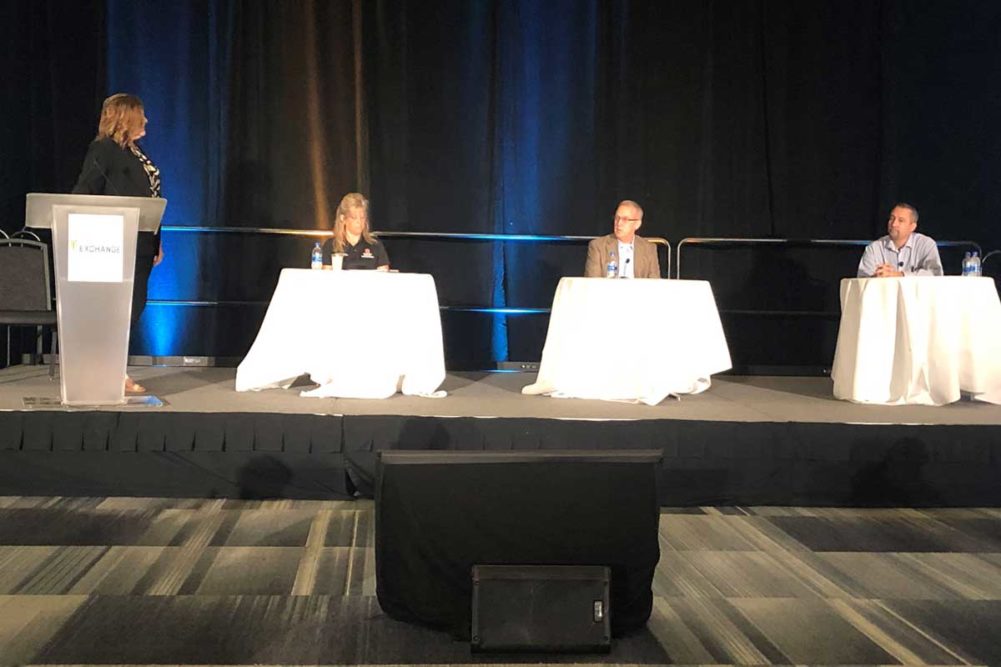COLUMBUS, OHIO, US — When creating a safety culture at a grain storage facility, it is best to be proactive rather than reactive.
That was the message a panel of grain industry safety experts conveyed to Grain Elevator and Processing Society members during a pre-conference workshop at the 2021 GEAPS Exchange, held Aug. 6-9 at the Columbus Convention Center.
“I’ve been fortunate enough to never be involved with a severe injury or fatality in my years in safety,” said Corey Hopkins, senior safety consultant, DEKRA Safety Management Systems. “But there have been near misses that could have resulted in a fatality or significant injury. In those cases, you must investigate them properly and implement corrective actions. You need to treat those near misses as an opportunity and make sure you learned from them.”
Panelist Nick Steinbach, safety coordinator at Two Rivers Cooperative in Pella, Iowa, US, said he has experienced the heartache of being on site when serious injuries occurred. He described the details of a 2011 incident in which two millwrights who were placing a distributor on top of a feed mill plummeted from the roof when the apparatus they were trying to dismantle came loose before they could hook it up to a crane.
“The two guys came down with the distributor … you could feel the ground roar,” Steinbach recalled. “I got in my Jeep to drive over and see what happened. One of the individuals was on the catwalk but we didn’t know where the other individual was. We ended up finding him on the side of the building in a snowbank.
“Me and four employees started administering first aid to these guys. The millwright crew had become part of our team; they came to the lunchroom and ate with us. We knew those kids pretty well. It was upsetting seeing them and wondering if they were going to live or die. Luckily, they both survived the fall.”
Dee Jepsen, professor of agriculture safety and health at The Ohio State University, noted that while agriculture-related injury and fatality numbers are declining in Ohio, there’s still too many incidents occurring on the farm and at commercial grain facilities.
“When you look at the types of injuries that occur at grain elevators, it’s usually trips and falls and not so much suffocation (from grain entrapment),” Jepsen said. “On the farm, 50% of fatalities are due to engulfment and another 25% are from being struck by or being knocked off something or being tangled in something.”
The GEAPS Exchange expo featured a wide range of technology designed to keep grain industry employees safe, including sensors, cameras and fall protection equipment.
As important as this state-of the-art technology is, being too dependent on it can lead to complacency, Steinbach said.
“Doing more with a lot less is one of our biggest challenges today — whether it’s budgets, time, manpower,” he said. “We’re getting stretched thinner. A lot of this technology is really cool but one of the old timers always told me there is no substitute for being able to look, listen, feel and smell.”
Jepsen said she thinks of safety as a triangle comprised of three equal points emphasizing technology, education, and enforcement.
“By enforcement, I don’t mean more OSHA regulations and oversight,” Jepsen said. “I’m talking about a company policy.”
A good safety program goes beyond identifying safety violations and punishing the individuals who commit them, Hopkins said.
“It’s not just about holding people accountable, it’s about setting clear expectations and then not tolerating variances,” he said.
Engaging as many employees as possible in a company’s safety efforts also pays dividends, Steinbach said.
“We rotate different people on our safety committee, so they get a taste of what’s happening on a monthly basis,” Steinbach said. “That way they’re able to see the reasons why we do things.”
Jeff Jones, vice president and director of eastern operations for MKC Cooperative and 2020-21 GEAPS international president, said a successful program involves commitment from upper management down to the lowest paid employees.
“You can spend all the money you want on safety, but it’s a culture,” Jones said. “You need to live it every day. We start every day with a safety talk on a safety topic.”
Because the grain industry is a tight-margin business, grain facility managers must carefully assess where to invest their money earmarked for safety.
“I would say as far as prioritizing, you should focus on the big-ticket items that cause the most significant injury or fatality exposure,” Steinbach said. “Lock-out tag-out, confined space entry, arc flash electrical safety, and fall protection — about 80% of significant injury or fatality exposures come from those areas, so don’t scrimp in those areas.”
Hopkins said that while several of his larger clients have their own trained rescue teams, most grain facilities will call their local fire departments when accidents occur, which is why it’s important to invite them on site so they can familiarize themselves with the facility and the types of rescues they may need to execute.
“You need to have the fire department’s phone number and should alert them when you are going to do a bin entry,” he said. “You need to make sure they’re available and not out on another call.”




